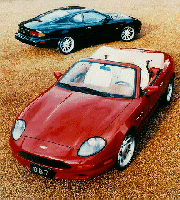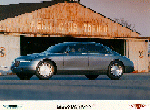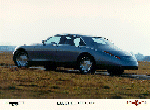 In 1996 the line-up was combined with a convertible version, mainly destined
for the US market:
In 1996 the line-up was combined with a convertible version, mainly destined
for the US market:
Like the coupe, the DB7 Volante's styling is the work of TWR design chief
Ian Callum. He said although he knew about a plan about the open version, but
while he figured out the shape of the DB7 coupe he focused on the closed
version only.
It worked: the transition from fixed-head to droph-head looks straightforward.
Park the two cars side by side, however and the differences will be
noticeable: every panel aft of the B-pillar has been re-sculpted, the fuel
filler has moved from C-pillar to wing top and the bootlid is much longer and
flatter.
To pass the tough US safety requirements the rear bumper had to be extended
by 78 mm.
The soft-top and retractable rear windows are making the two rear seats
useless. Otherwise the cabin looks the same.
Under the bonnet the Volante has the same supercharged, 3.2-litre straight
six as the coupe with 5-speed manual or 4-speed automatic gearbox.
The Bridgestones tires have been specially designed to the DB7.
|


|
In June, 1997 Dunhill and Aston teamed up and built a very special DB7 with
cigar-holders around. It currently travels around and will be available
in a very limited number from next year.
Also at the 1993 Geneva Motorshow another new Aston appeared:
Aston Martin Lagonda Vignale



|
Extracts from the press release, handed out at the introduction at
the Geneva Salon, 1993:
Following an interval of almost 40 years, Aston Martin Lagonda has
renewed its relationship with Ghia Design of Turin and commissioned
a design study for a concept vehicle to investigate and research
the materials and techniques which would justify the continued
production of the hand-made luxury saloon car beyond the year
2000...
Drawing on the worldwide resources of the Ford Motor Co, Aston
Martin engineers have identified an advanced concept for a V12
engine which could be developed for the Lagonda Vignale".
|
© May 1995-1997. Paul Negyesi npaul@hu.inter.net

 In 1996 the line-up was combined with a convertible version, mainly destined
for the US market:
In 1996 the line-up was combined with a convertible version, mainly destined
for the US market: